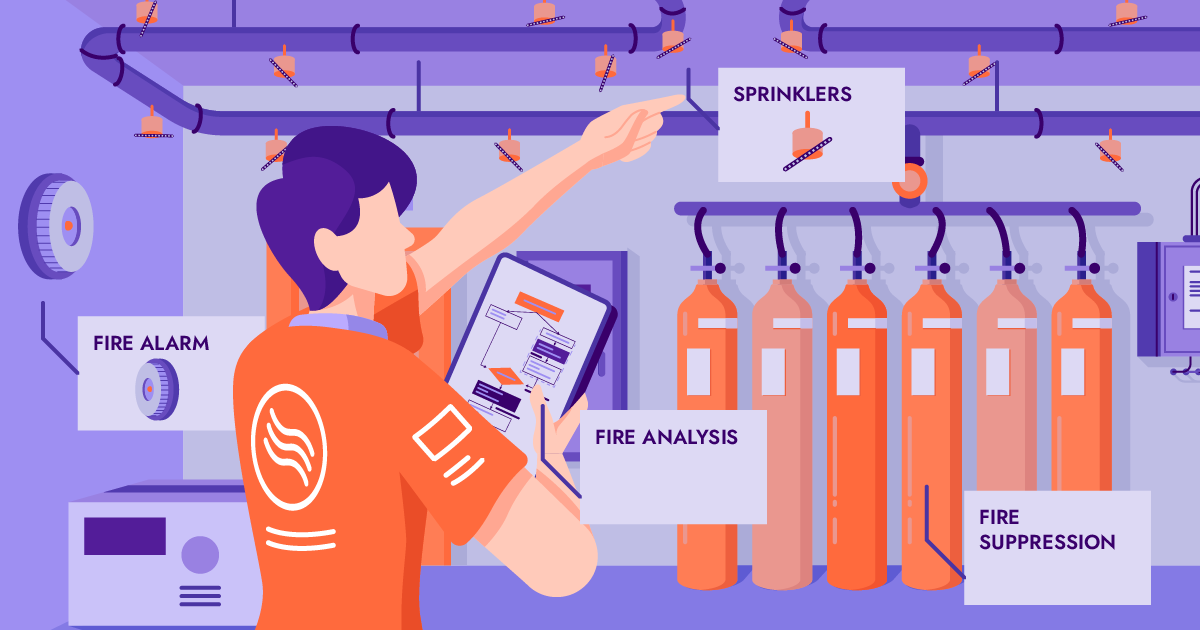The Guide to Fire Safety Equipment Inspection

Welcome to a world where fire safety transcends routine checks and becomes a pivotal component of your overall security and compliance strategy. This guide aims to simplify the complexities surrounding fire safety equipment inspection, turning it into a practical blueprint for ensuring your assets are protected, your environment is compliant, and your mind is at ease.
Key Takeaways:
- Embrace Regular and Thorough Inspections: Regular fire safety equipment inspections, detailed in our guide, are essential for operational readiness. Focusing on critical equipment like fire extinguishers, sprinkler systems, and emergency lighting ensures your safety measures function flawlessly when needed most.
- Achieve Mastery in Compliance: Navigating and adhering to fire safety regulations is simplified with our insights on balancing local and international standards, underscored by the importance of meticulous documentation. Utilizing digital platforms like FieldInsight can streamline this process, ensuring your facility remains compliant effortlessly.
- Foster a Culture of Safety and Continuous Improvement: Adopting best practices, integrating the latest technology, and establishing feedback loops are fundamental in creating a safety-first mindset. Our guide encourages ongoing education and the use of data analytics for evolving your fire safety protocols, setting a new standard in safety excellence.
Precision in Regular Inspections: Ensuring Operational Readiness
Conducting regular fire safety equipment inspections is akin to ensuring a well-oiled machine—every gear needs to function flawlessly to prevent breakdowns. This section dives into the intricacies of inspecting critical equipment such as fire extinguishers, sprinkler systems, and emergency lighting.
- Fire Extinguishers: Focus on checking pressure levels, ensuring accessibility, and verifying the seal and pin integrity. A monthly inspection can prevent failures, with a professional inspection required annually.
- Sprinkler Systems: Highlight the importance of visual inspections for corrosion, obstruction, and proper signage. An annual professional inspection checks the system’s functionality, water flow, and alarm systems.
- Emergency Lighting: Emphasize the need for monthly tests to ensure lights function for the required duration and annual tests to verify battery and charger health.
Mastery of Compliance: Navigating Fire Safety Standards
Navigating the maze of fire safety regulations requires a keen understanding of both local and international standards, meticulous record-keeping, and a strategic approach to ensure ongoing compliance. This expanded section offers actionable insights into managing these aspects effectively, tailored to a diverse international audience.
Understanding and Applying Local vs. International Standards
Fire safety regulations can vary significantly from one country to another, and often, within countries themselves. Here’s how to navigate these differences:
- Research and Understand Your Obligations: Start by identifying the specific fire safety codes applicable to your location. In the U.S., the NFPA codes provide a comprehensive framework for fire safety. Australians should refer to the Building Code of Australia (BCA) and associated Australian Standards (AS), such as AS 1851 for routine service of fire protection systems and equipment. Canadians can rely on the National Fire Code of Canada (NFC) as their guiding document.
- Comparing Standards for Multinational Operations: For organizations operating in multiple countries, it’s crucial to compare these local standards against international ones, like the International Fire Code (IFC) or the European Norms (EN) in Europe. When discrepancies arise, adhering to the stricter standard is prudent to ensure the highest level of safety across all locations.
- Adaptation and Compliance: Implementing a compliance strategy that can adapt to the most stringent regulations ensures your facilities are prepared to meet diverse requirements, providing a consistent safety protocol across your operations.
The Critical Role of Documentation
Keeping thorough records is essential for efficient fire safety management and goes beyond legal requirements. Here’s how to ensure your documentation supports compliance:
- Digital Transformation with Tools like FieldInsight: Transitioning to digital platforms for your fire safety documentation can significantly enhance the efficiency and reliability of your record-keeping. Platforms like FieldInsight allow you to store inspection reports, maintenance records, and drill logs in a centralized, easily accessible location. This digital approach facilitates real-time updates and sharing, ensuring all stakeholders have access to the latest compliance data.
- Audit Trails and Compliance Evidence: Accurate records serve as invaluable evidence during compliance audits, demonstrating your commitment to fire safety and regulatory adherence. Ensure your documentation includes dates, actions taken, individuals involved, and any follow-up measures required. This level of detail not only supports compliance but also helps in identifying trends and areas for improvement in your fire safety protocols.
- Regular Reviews and Updates: Fire safety standards and regulations are subject to change. Regularly review your documentation practices and the platforms you use to ensure they remain aligned with current standards. Updates to digital platforms like FieldInsight are typically automatic, ensuring you’re always working with the latest features designed to support compliance.
Creating a Comprehensive Inspection Checklist: Your Safety Blueprint
A detailed inspection checklist is your roadmap to comprehensive fire safety. This section guides you through creating a checklist that covers all critical areas, from daily visual checks to in-depth annual inspections.
- Equipment Checks: Detailed listing of what to inspect, including fire doors, extinguishers, alarms, and escape routes, with a focus on what specifically to look for in each item.
- Evacuation Drills: How to plan and record evacuation drills, including frequency and evaluation criteria to ensure effectiveness.
Simplifying Inspections with FieldInsight: Enhancing Operational Efficiency
FieldInsight’s platform offers a suite of features designed to streamline and optimize fire safety inspections. Here’s how FieldInsight helps fire safety businesses in simplifying their inspection processes:
Automated Scheduling and Reminder System
One of the primary challenges fire safety businesses face is managing the scheduling of regular inspections across multiple clients and locations. FieldInsight addresses this by:
- Automating Inspection Schedules: Businesses can input the frequency of required inspections for each piece of equipment or facility once. FieldInsight automatically schedules these inspections accordingly, ensuring no inspection is overlooked.
- Sending Automated Reminders: FieldInsight sends reminders to technicians and clients about upcoming inspections, ensuring preparations are made and access is granted. This minimizes delays and ensures inspections are completed on time.
Real-time Data Collection and Reporting
Gathering data during inspections and compiling reports can be time-consuming. FieldInsight simplifies this through:
- Mobile Data Collection: Technicians can enter inspection data directly into FieldInsight via mobile devices while on-site. This includes checklists, notes and photos providing a comprehensive overview of each inspection.
- Instant Report Generation: Once data is submitted, FieldInsight automatically compiles it into professional reports that are ready to be shared with clients or regulatory bodies. This not only saves time but also enhances the accuracy and reliability of the reports.
Compliance Tracking
Staying abreast of and complying with changing fire safety regulations can be daunting. FieldInsight helps by:
- Regulation Database: Keeping a regularly updated database of local and international fire safety regulations within the platform. Businesses can quickly reference these to ensure inspections meet the latest standards.
- Compliance Dashboard: Offering a dashboard view that highlights any areas of non-compliance, allowing businesses to take corrective action promptly. This proactive approach helps maintain compliance and reduces the risk of penalties.
Client and Asset Management
Managing client information and the details of each asset being inspected can get complicated as businesses grow. FieldInsight offers solutions through:
- Centralized Client and Asset Database: All client information and detailed records of each asset (including location, inspection history, and maintenance records) are stored in one place. This makes it easy to access and manage information efficiently.
- Asset Tagging with QR Codes: By using QR codes for each asset, technicians can quickly access all relevant information and inspection history by scanning the code, streamlining the inspection process.
By leveraging FieldInsight’s automated scheduling, real-time data collection, compliance tracking, and efficient client and asset management features, fire safety businesses can significantly simplify the inspection process. This not only enhances operational efficiency but also improves accuracy, compliance, and client satisfaction. FieldInsight provides a comprehensive solution that addresses the specific needs of the fire safety industry, making it an invaluable tool for businesses looking to streamline their operations and focus on growth.
Raising the Bar with Best Practices: A Culture of Safety
Adopting best practices in fire safety inspections sets the foundation for a culture of safety. This segment discusses how to integrate continuous education, the latest technology, and stakeholder engagement into your fire safety strategy.
- Continuous Education: Implementing regular training sessions for your team on the latest fire safety protocols and equipment use.
- Technology Integration: Exploring advanced fire detection and suppression technologies that can be incorporated into your safety measures.
Continuous Improvement: Beyond the Checklist
Fostering an environment of continuous improvement ensures your fire safety measures are always evolving. This final section outlines strategies for analyzing inspection data, gathering feedback, and refining your fire safety protocols for better outcomes.
- Feedback Loops: Creating channels for feedback from employees and inspectors to identify areas for improvement.
- Data Analysis: Utilizing FieldInsight’s data analytics to track trends in equipment failures or inspection results, informing your strategy for adjustments and enhancements.
In wrapping up, this guide underscores the importance of meticulous inspections, mastering compliance , and a proactive safety culture in the fire safety industry. FieldInsight emerges as an indispensable ally, streamlining these facets with its innovative features like automated scheduling, real-time reporting, and comprehensive compliance tracking.
FieldInsight not only propels fire safety businesses towards operational excellence but also ensures they stay ahead in a competitive and regulatory complex landscape. It’s an invitation to elevate your fire safety standards, enhancing efficiency and client trust across the globe.
What You Should Do Now
- Book a Demo. You’ll be in touch with an automation expert who has worked in this space for over 5 years, and knows the optimal workflow to address your needs.
- If you’d like access to free articles about managing HVAC workflows, go to our blog.
- If you know someone who’d enjoy reading this page, share it with them via email, Linkedin, Twitter, or Facebook.






